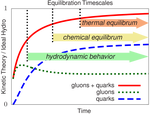Chemical equilibration
Quark production in weakly coupled QCD plasma
 Different equilibration scales in expanding quark-gluon plasma.
Different equilibration scales in expanding quark-gluon plasma.
The current hydrodynamical models of heavy-ion collisions use equation of state for the pressure and energy relation, which assumes the thermodynamic equilibrium between the three light flavour quarks and gluons with the same temperature. However such chemical equilibrium in the quark-gluon plasma created in nuclear collisions is by no means guaranteed. This is because in the high-energy limit the energy deposition in the central region of the collision is dominated by gluonic fields with almost no quarks present initially and which have to be produced later. On the other hand, the observed yields of produced hadrons (including strange hadrons) are well described by a chemical equilibrium temperature of $T_{\mathrm{chem}} ≈ 156\, \mathrm{MeV}/k_B$ in the largest nucleus-nucleus collisions1. This is suggestive that chemical equilibrium is reached in the quark-gluon plasma at least in the largest collision systems.
I have recently performed the first leading order (in coupling constant) QCD kinetic theory simulations with both gluon and quark degrees of freedom. We determined the relative ordering of important equilibration time-scales between the emergence of fluid-like behaviour, quark and gluon chemical equilibration, and the approach to thermal Bose-Einstein and Fermi-Dirac equilibrium (see Figure). In the accompanying Letter we demonstrated that the observed hadron chemical equilibrium for large number of produced charged particles is indeed consistent with kinetic theory results of chemically equilibrating quark-gluon plasma.
-
A. Andronic, P. Braun-Munzinger, K. Redlich and J. Stachel, Decoding the phase structure of QCD via particle production at high energy, Nature 561 no. 7723 (2018) ↩︎

